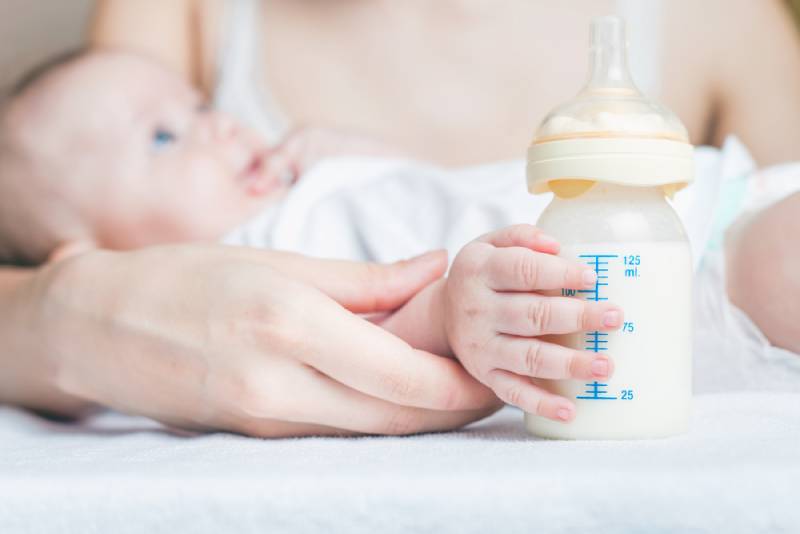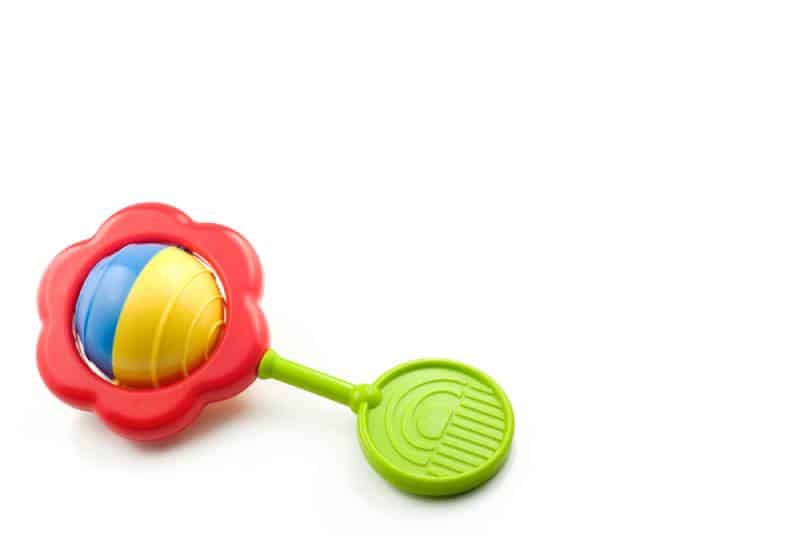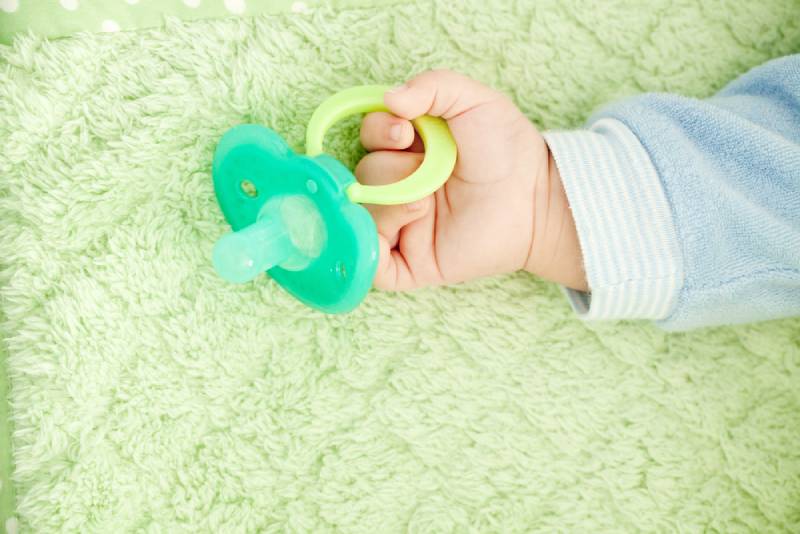Just when you thought you were nailing this parenthood thing, you run into another roadblock – your baby refuses the bottle and you’re at a loss for what to do, with a million questions in mind.
So why does this happen to begin with?
When a breastfed baby refuses the bottle, it’s usually because she has become so accustomed to nursing that introducing bottle seems like a battle you’re bound to lose.
But sometimes even a baby that’s used to bottles can wake up with a bad case of bottle refusal – this is a developmental step many parents aren’t aware of, so it takes them by surprise.
Luckily, there are tried and tested ways of getting your little one on the right track with baby bottles.

In my experience, the most important thing was to find the perfect bottle that could mimic being breastfed.
But if you’ve found yourself in a situation where no bottle seems to be working, and you’re freaking out about how in the world are you going to be able to go back to work when your baby refuses to eat, I’ve prepared tips for you as well!
Be prepared to arm yourself with bottles and lots of patience, because you’ll need it as you shuffle through different strategies for when your baby refuses the bottle.
I’m sure that you’ll find something that will work for you and your little one, so read on!
Getting the perfect bottle
It might seem a little obvious, but finding the perfect bottle for a breastfed baby can make the world of difference.
There are bottles (and pacifiers) specifically designed with breastfed babies in mind to help create a smooth transition, and sometimes you might need to shuffle between a few brands to find the right one.
For older babies, you can even skip the bottle stage and move onto sippy cups they can hold themselves.
I’ve got a quick list of bottles and sippy cups I would personally recommend to all parents who are preparing to take this next big step with their baby, so you can make the best possible choice!
1. Comotomo Baby Bottle
- Comotomo baby bottles are deisgned to most closely mimic breastfeeding to reduce bottle rejection and nipple confusion issues
- Ultra wide-neck design allows easy cleaning by hand without a brush. Nipple and body is made of 100% safe hygienic silicone
- Maximum temperature for bottle and nipple is 180 degree Celsius and 120 degree Celsius for cap and outer ring
- Dual anti-colic vents prevent unwanted air-intake and reduce colic
Prices pulled from the Amazon Product Advertising API on:
Product prices and availability are accurate as of the date/time indicated and are subject to change. Any price and availability information displayed on [relevant Amazon Site(s), as applicable] at the time of purchase will apply to the purchase of this product.
Baby bottles seem to be getting more adorable by the day, and the Comotomo ones are no exception.
My bestie got these cute baby bottles at her baby shower and they’ve done a great job at transitioning her baby boy to a bottle.
The bottle’s nipple is made to resemble the real deal as much as possible, which helps a lot to curb bottle rejection.
The silicone is also designed to resemble human skin, since babies love to grab at their mom while they nurse, and feeling a plastic bottle in their tiny hands might cause them to reject the bottle completely.
You only have a choice between two colors – pink and lime green – but I really like the minimalist design.
And they’re not hard to clean out either if you’re not using a baby bottle sterilizer (though I strongly recommend it).
My bestie told me that they’re so wide so she can handwash them without having to maneuver her hand around or use a brush.
2. Lansinoh Breastfeeding Bottles for Baby
- REDUCES NIPPLE CONFUSION: The NaturalWave Nipple is clinically proven to reduce nipple confusion. It enables baby to use the same natural feeding actions breastfed babies learn when breastfeeding and keeps baby breastfeeding longer.
- ANTI-COLIC DESIGN: Lansinoh breastfeeding bottles feature a unique air venting system that reduces babys intake of gas, a potential cause of colic & spit up.
- EASY AND EFFECTIVE: A Lansinoh baby bottle feature a one piece nipple that is easy to clean and a wide base that makes it easy for baby to latch on & create a secure seal.
Prices pulled from the Amazon Product Advertising API on:
Product prices and availability are accurate as of the date/time indicated and are subject to change. Any price and availability information displayed on [relevant Amazon Site(s), as applicable] at the time of purchase will apply to the purchase of this product.
These 5-ounce baby bottles by Lansinoh were always the first ones I reached for when I wanted to transition my babies from nursing to bottle feeding.
But even as I was introducing my babies to the bottle, I wanted to continue nursing them, and Lansinoh bottles did a great job of preventing nipple confusion.
Since the nipple is only slow flow, it allows the baby to nurse in the same way they would on a breast and you can be sure that your little one won’t suddenly start rejecting breastfeeding altogether.
And the nipple isn’t very big either, so there’s no need to be afraid that it will trigger your baby’s gag reflex.
3. Tommee Tippee Closer to Nature Baby Bottle
- ACCEPTANCE GUARANTEED*: Breast-like shaped nipple for an easy and natural latch – 97% mom recommended**
- NATURAL FEEL: Super-sensitive bottle nipple flexes like mom, smooth silicone feels closer to skin
- ANTI-COLIC: Optimum venting anti-colic nipple valve for less air intake and less discomfort for baby
- EASY TRANSITION: Feeding bottle is ideal for breastfed babies
Prices pulled from the Amazon Product Advertising API on:
Product prices and availability are accurate as of the date/time indicated and are subject to change. Any price and availability information displayed on [relevant Amazon Site(s), as applicable] at the time of purchase will apply to the purchase of this product.
Some babies have more sensitive tummies than others and colicky babies need special attention when you’re picking out a baby bottle.
The Tommee Tippee bottles have a nipple that prevents extra air from getting in and causing trouble for your baby (and no mama wants that on top of transitioning their munchkin to a bottle).
The nipple is also very soft and designed to help the baby feel like he’s still nursing.
I know a few moms that didn’t go with Tommee Tippee as a first choice, but after a few failed tries with other bottles, these ended up being what their baby liked best.
And they’re pretty inexpensive as well, so it doesn’t hurt to give them a try!
4. NURSH Reusable Silicone Pouch Bottle
- Air-free FEEDING: innovative silicone pouch collapses as baby drinks, cuts down on the ingestion of air to decrease painful gas, colic and Burps
- Modeled AFTER moms: designed to mimic the natural form and feel of mom for baby feeding, easy to latch and encourages proper tongue positioning
- Easy to clean and washable: 100% dishwasher safe bottles, can be boiled, microwaved, frozen and sterilized
Prices pulled from the Amazon Product Advertising API on:
Product prices and availability are accurate as of the date/time indicated and are subject to change. Any price and availability information displayed on [relevant Amazon Site(s), as applicable] at the time of purchase will apply to the purchase of this product.
Nursh bottles by Boon are equipped with a slow flow nipple and are pretty unique compared to a lot of the other bottles on the market.
I remember seeing them for the first time in the diaper bag of one of the moms from my daughter’s dance class – I was instantly intrigued!
These bottles are actually pouches that shrink as the baby feeds, which decreases the amount of air and is great for colicky babies.
The nipple is designed to enable your baby to put her tongue in the right position and is great for switching her over to a bottle from nursing.
That dance class mama also told me that these bottles are so easy to take apart and clean since they’re so wide.
And the width of the bottle allows you to pour milk without spilling it all over the counters – kudos for less cleanup!
5. Philips Avent Natural Baby Bottle
- The most natural way to bottle feed; Natural nipple shape makes it easy for baby to combine with breastfeeding
- Wide, breast shaped, soft, flexible, silicone nipple promotes natural latch on, so its easy to combine with breastfeeding
- Advanced anti colic valve designed to reduce colic and discomfort by venting air into the bottle and not babys tummy
Prices pulled from the Amazon Product Advertising API on:
Product prices and availability are accurate as of the date/time indicated and are subject to change. Any price and availability information displayed on [relevant Amazon Site(s), as applicable] at the time of purchase will apply to the purchase of this product.
Philips Avent is one of those tried and tested brands that parents can turn to when the more modern versions of bottles let them down.
The flow of the nipple helps babies that breastfeed get used to bottle feedings without causing nipple confusion. Just make sure to choose the right Avent nipple size.
The design also prevents colic by reducing the amount of air that goes into the stomach of the baby.
If you find that these bottles work for you, you can mix and match them with other Philips Avent nipples that are fast flow and can adjust to your little one as she grows.
6. Medela Breastmilk Bottle Set
- Compatible with all Medela breastpumps, so you can pump, store and feed with one container
- Great for long term storage
- Measure the exact amount of milk youre pumping with the colorful ounce and millimeter markers
Prices pulled from the Amazon Product Advertising API on:
Product prices and availability are accurate as of the date/time indicated and are subject to change. Any price and availability information displayed on [relevant Amazon Site(s), as applicable] at the time of purchase will apply to the purchase of this product.
This Medela bottle set comes with 5-ounce bottles and slow flow nipples that are perfect for nursing babies until 3 months of age.
If you have an older baby, the 8-ounce bottles come with nipples that are medium flow and will satisfy babies from 4 to 12 months of age.
These bottles are an especially good choice if you already have a breast pump by Medela, since you can pump your milk directly into the bottles.
The downside is that the Medela bottles are not as wide as some of the other models, so cleaning is not as easy.
7. NUK Simply Natural Baby Bottle
- Multiple nipple holes provide a natural feed, just like moms breast.
- Advanced 1-piece Anti-Colic Air system helps reduce colic, gas and spit up
- Super soft silicone nipple is the same shape as moms nursing nipple for a familiar fit. Flexible nipple moves with baby for a continuous latch
- Recommended by 90% of Moms - based on a July 2015 home use test. Moms agree that they provided their babies with natural, close-to-mom comfort.
Prices pulled from the Amazon Product Advertising API on:
Product prices and availability are accurate as of the date/time indicated and are subject to change. Any price and availability information displayed on [relevant Amazon Site(s), as applicable] at the time of purchase will apply to the purchase of this product.
NUK plastic bottles come in a variety of sizes, but the 5-ounce bottle is the best choice for a breastfeeding baby.
The nipple is designed to be slow flow, but it comes with 3 holes to be as similar as possible to mom.
What might pose a cleaning challenge is the teat is covered with small ridges that might be difficult to scrub.
But the nipple is very soft and small, so it can be a great fit for younger babies.
8. NUK Simply Natural Learner Cup
- Promotes easy drinking transition from breast to bottle to independent feeding
- Spout is 45% wider for a more natural feel, allowing baby to grow with the NUK Simply Natural platform of natural feeding
- Cup features ergonomic, easy to hold handles, spill-proof, soft silicone spout, Anti-Colic Air Vent that helps reduce swallowing air
Prices pulled from the Amazon Product Advertising API on:
Product prices and availability are accurate as of the date/time indicated and are subject to change. Any price and availability information displayed on [relevant Amazon Site(s), as applicable] at the time of purchase will apply to the purchase of this product.
As I will explain a little further down, some babies just never take to a bottle, no matter how many weeks of patient practice you put into it.
And this is okay! It’s definitely not the end of the world.
There are learner sippy cups, such as this one by Nuk, that are specially designed for little ones like this.
Appropriate for babies who are at least 6 months old, the cup comes in three different colors – white, pink, and blue æ with friendly owl, butterfly, and whale designs in the front.
The handles are easy for a baby to hold while the bottle design prevents spilling or leakage.
It also comes with a cap, so you can put it in your purse or diaper bag without worrying about it getting dirty or spilling all over.
Planning ahead of the bottle
Not all babies will automatically refuse to drink out of a bottle.
In fact, newborns up to 3 months old will usually take to a bottle very quickly and easily.
The secret lies in their sucking reflex, which goes away around the time they’re 3 months of age.
The bad news is that if by this point they haven’t encountered a bottle, they’re likely to refuse it.
What does this mean?
For one, you definitely shouldn’t wait until the last moment to give your baby a bottle.
I’ve seen many parents who decided to do this just a week before the mom is due to go back to work, only for them to realize that the baby will not feed out of anything that’s not attached to mom!
If you’re planning on breastfeeding and then switching to formula or expressed milk, you should offer a bottle feed to your baby several times a week, so he can get familiar with the artificial nipple.

But be careful not to do this before the baby is one month old.
If you do, this may lead to what is called “nipple confusion.”
Nipple confusion means that the baby doesn’t know how to suck during breastfeeding, for example, since a bottle needs a different kind of sucking action.
Or the baby could just start refusing the breast since bottles can express milk much faster.
In both cases, you might have to cut down on the breastfeeding early, which is obviously something you might not want.
In my case, I’d offer a little bit of expressed milk in a bottle two to three times a week and that did the trick!
Also, there’s no need to feed the baby a full bottle of milk.
Usually, just a few sips are more than plenty to get them used to a bottle.
I’ve also noticed that a lot of parents only give a bottle to their baby once before the 3 months are up, and relax after they see that the baby accepted it.
The thing is, older babies get very used to being breastfed and could give parents a very hard time, which is why it’s important to regularly expose them to the bottle.

As you can see, it’s a very slow and careful dance between not giving the baby too much or too little of the bottle, but it’s definitely manageable – you’ve just got to plan ahead!
But there are also parents who manage to successfully juggle both breastfeeding and bottle feeding only to wake up one day and discover that their baby can’t stand the sight of a bottle anymore.
This usually happens when the baby is 2 months old and is a milestone most parents don’t see coming.
At this age, babies begin to recognize faces and can tell the difference between mom’s breast and a silicone bottle.
Naturally, they prefer being held close by the comforting arms of their mother and will loudly voice their protest if anyone else tries to feed them.
Regardless of what your individual situation is, I’ve compiled a number of useful tips and tricks you can try to apply as you transition your baby to a bottle.
If the baby is still refusing the bottle
Let’s say your baby didn’t get used to being bottle-fed on time and now you’re nervously googling and texting your other mom friends because you feel like you’re all out of options.
I’m here to assure you that you’re not – there so many strategies you can try before waving that white flag!
Get the family involved
Feeding is such a natural process between mom and baby that it might have not even crossed your mind that you should let someone else try to introduce the bottle.
The thing is, a lot of babies just don’t want a bottle to go near their mouth when mom is holding them.
My own daughter was like this – bottle refusal was only a problem if I was holding her (or was even in the room) because she knew very well that another option (a.k.a. me) was there, and it’s only natural she preferred nursing.
This is a great time to get Dad involved in the feeding process.
If your little one is resistant to this, he can try taking off his shirt since a lot of babies enjoy the close skin-to-skin contact they have when nursing.
But if Dad isn’t available, another member of the family, like the grandparents, could jump in to help.

We sometimes forget that our own moms brought up babies of their own and also have a way of predicting what the baby needs.
In our case, after some time of bottle feeding only with her dad, my daughter got used to the feedings even with me in the room and I was able to enjoy feeding her from a bottle as well!
But for every baby that won’t take a bottle with mom in the room, there is one that absolutely needs to feel their mama in some way in order to eat.
My sister-in-law used to go to bed with a burp cloth that her nanny would then use the next day to wrap the bottle in it.
Just the scent of her mom got my niece relaxed and comfortable enough to take a bottle.
You can do the same with a bib, a small towel, or any small item of clothing that easily wraps around a bottle.
Try different positions
I made the mistake of thinking that the best feeding position for bottle feeding my daughter was the exact position she was used to nursing in.
But obviously, this was not the case, so we had to learn by trial and error. (But some babies do really well in this position. You just got to love how unique they are!)
Once I adjusted her into a sitting position, with her head propped up against my chest, she took to a bottle much faster.
If this doesn’t work, you can try getting a nursing pillow and lay your baby down with her head slightly propped up by the pillow while you hold the bottle.

You can also hold her so that she faces out, either while you walk around the room or sit.
Another option is for you to lie down and lift your legs up (couches are perfect for this) and place your baby in your lap.
Your knees will support her head as you give her the bottle, but you’ll still be able to see each other.
Of course, the feeding position will always depend on how old your baby is and what her feeding time is – older babies can do very well in upright positions, but this might not be possible with younger ones.
This is why it’s always a good idea to talk to your lactation consultant or pediatrician to get valuable and professional advice.
Experiment with different temperatures
If your baby is still refusing a bottle, maybe you should check the milk temperature.
Even though breast milk has a lukewarm temperature, a baby might also like milk that’s cold or room temperature, so you can try different variations to see what she likes.
But milk is not the only thing you should keep an eye out for when it comes to temperature.
When my son was a 3 month old, he had already started teething.

For teething babies, you can put the teat or the nipple of the bottle into the fridge to cool.
This will not only help them adjust to a bottle faster, but will also soothe their gums.
If your baby is not teething, however, it could help to put the nipple in a bit of warm water so that it’s not completely cold when it reaches the baby’s mouth.
Putting a little bit of milk on the nipple could also make it more appealing to the baby.
Distractions
For better or for worse, babies are so easy to distract!
This comes in really handy if your baby is resistant to bottles.
One of the things you can try that usually worked for my son was to just walk and rock him around the room, keeping him happy and entertained.
At some point, he would usually accept the bottle.
Then there’s the “element of surprise” method which involves having the baby suck on a pacifier or a finger and replacing it swiftly with a bottle.

Sure, it’s a little deceptive, but if it works, why not?
If nothing else worked, I always grabbed a toy he really liked and encouraged him to play with it as I gave him the bottle.
This also prevents the baby from getting really upset and refusing to eat altogether.
Another great tip is to try and get the baby to latch onto the bottle as she’s waking up or falling asleep.
The disorientation could work in your favor and she could take the teat without a fuss.
Different feeding times
While it makes perfect sense to try and introduce a bottle to babies during their regular feeding time or when they’re really hungry, this often doesn’t work.
Why?
Well, hungry babies are cranky babies, and cranky babies don’t really have the energy or the time to focus on this new thing that’s trying to feed them.
At this point, they just want to be fed and don’t care for much else.
One of the best times to try a bottle feed is between meals when your baby is in that sweet spot when she’s not too hungry but not too full either.
This way, the new experience becomes a fun activity without the pressure of a hungry and crying infant.

A calm and quiet atmosphere is also very important for a successful bottle transition.
This might be easy in a one-child household, but as soon as you add an older sibling to the mix, things get a lot more active and exciting!
And babies might find a loud and noisy atmosphere a bit too much to handle.
That’s why I always suggest moving to another room where you can be alone with your little one and create a serene atmosphere where your baby can relax.
It’s also important for you to feel the same way as well, so if it’s been a long day and you’re feeling on edge, it’s probably best to postpone the bottle training for another day.
Try different nipples and teats
Not all nipples are made equal! Especially the bottle ones.
Many brands design bottle teats that imitate an actual breast to increase the chances of the baby latching on as quickly as possible, and this is definitely something to look out for when buying a bottle.
But the teat should be made from soft silicone, otherwise your baby will be able to tell the difference very easily and will probably let go.
When it comes to nipples, some bottles come with longer ones that can cause babies to gag and are generally a bad choice for newborns.

The ideal bottle nipple should be in the sweet spot between being not too hard and not too soft.
Keep in mind that softer nipples usually wear out quickly, so you will need to replace them, while the harder ones are sturdy and last longer.
Unfortunately, there is no way of really knowing what type of nipple your baby will prefer, so it’s a matter of trial and error until you discover the perfect one.
That said, if your baby is using a pacifier, try to pick a nipple that is made from the same material, like silicone, for example.
Adjusting the flow of milk
Breastfed babies are used to a slower flow of milk, so be sure to pick a nipple size that can accommodate your baby.
Generally, a slow flow nipple is good for infants from birth to 3 months of age, medium flow is from 3 to 6 months, while a faster flow is okay for babies from 6 to 12 months of age.
But there are also other signs to look out for when your little one is not comfortable with the nipple size.

A telltale sign with my baby boy was him getting cranky half-way through the feeding and trying to get away from the bottle.
Other signals also include the baby getting hungry very quickly after the feeding, taking longer than usual to finish their bottle, sucking very intensely, or making the nipple flat.
Give paced bottle feeding a try
Paced bottle feeding is great for breastfed babies because it imitates the way babies nurse from a breast.
With paced feedings, you should gently bring the bottle nipple to the baby’s mouth and touch her lip until she opens her mouth.
Keep the bottle horizontally tipped and the nipple half-full with milk, so that your little one can adjust the milk flow to her liking.

If you notice that the baby is gulping or isn’t relaxed anymore, simply lean the bottle back (but don’t pull it out completely) until the baby draws the nipple back in.
Paced feedings are not only an effective way of introducing a bottle to a breastfed baby, but it won’t completely change the way your baby feeds, so you can continue nursing if you would like to.
Try a pacifier
Pacifiers are pretty divisive – some parents are all for them, while others believe they cause more harm than good.
Without getting too much into it (this choice is only up to you, after all), you can give a pacifier a try if you’re struggling to make headway with any of the other strategies.

A lot of babies who reject bottles just dislike the feel of rubber or silicone in their mouth, so giving them a pacifier several times throughout the day could help them get used to the sensation.
RELATED: Best Pacifiers For Breastfed Babies: 8 Top Choices
Take baby steps
In some cases, babies need a lot of gentle coaching to get used to the feel of a silicone nipple in their mouth.
A way of doing that is to get the nipple (not the whole bottle) and take it to the baby’s mouth – you can try gently rubbing it on the inside of the baby’s cheeks and gums.
When the baby starts sucking on the nipple (you can encourage this by putting your finger inside the nipple and making small movements on the tongue of the baby), try pouring a tiny bit of milk down the nipple.

While this process can seem a bit long and complicated, a few moms in my family have had a lot of success with this technique.
Especially when nothing else seems to be working and the baby is turning away at the mere sight of a teat.
What to do when nothing else works
Now I don’t want to scare you, but you could find yourself in a situation where the baby is just not responding to anything – not the positioning, the milk temperatures, the toys, or their beloved grandma coming over to try and feed them.
And I’ve known babies who go straight from being breastfed to eating solid foods, without ever using a bottle.
In this case, it’s so important to be patient and calm. This is not the time to turn bottles into a battleground.
Besides, trying to force the baby to drink from a bottle will just backfire and could lead to a permanent aversion to bottles, which is something nobody wants to happen.
Remember, your baby is not doing this to spite you, but because she doesn’t know any better.
For her, the only milk supply she cares about comes from her mom.
But time is running out and you need to find a way of feeding your little one before maternity leave is up and she’s left in the hands of a daycare, nanny, or another caregiver.

One of the best ways to do this is to teach your little one how to drink out of an open cup.
First off, you would need to get a small glass or cup and put your baby on your lap so that he’s sitting upright.
Very carefully, bring the cup to your baby’s mouth and tilt it so that he can feel the milk.
Most babies will stick their tongues out to taste the milk and will begin to sip it.
Be patient, though, this takes a lot of practice and might get messy in the beginning.
Make sure to arm yourself with bibs and towels!
Younger babies can also be fed through an oral syringe or dropper.
For older babies, even a sippy cup can come into play, but this should be reserved for babies who are able to sit upright and are older than 6 months.
Additionally, they should never be left alone while drinking.
Dealing with reverse cycle nursing
But regardless of whether you’ve managed to successfully switch your baby to a bottle or not, you should definitely brace yourself for something called reverse cycling or reverse cycle nursing.
Reverse cycling happens when a baby gets hungry and wants to eat at night as opposed to during the daytime.
But why does this happen?
Shouldn’t a baby continue to get hungry more during the day?
Well, with the shift in your schedule and mom being gone during the day, some babies begin sleeping more and eating less during the day.
And then they make up for it at night when mom is there because they simply prefer the cuddles and attention they get from their favorite person.
Okay, while it is definitely wonderful to know that the baby still prefers being fed by mom – even if it is from a bottle – we still need our sleep to function the next day!
Especially if you have an 8-hour workday ahead of you.

I have to admit, though, that by the time my second was going through his reverse cycling, I was a stay-at-home-mom, which meant I could get an extra nap here and there during the day.
But I know that not all moms are this lucky!
One of the best ways to reduce the amount of time you spend out of bed during the night is to get a co-sleeper at your bedside, so your baby is right there when she needs to be fed.
Or you can move the crib from her bedroom to yours. In either case, it’s important that your little one is close by.
You can also try and go to bed earlier than usual to sneak in some extra hours of sleep and use mornings or other times of the day to catch up on errands you would usually finish up later at night.
And if you can, try and use the weekends to catch up on some sleep – this can be a great moment for the entire family to pitch in and help out.
If you have an older child, for example, they could spend the Saturday having a picnic with their grandparents.
To conclude
It seems like every stage of parenthood comes with fresh challenges!
Sometimes it can feel like you have absolutely no idea what you’re doing, but you’ve just got to hang in there and go with the flow.
Every baby is different and unique, so what works for one might be totally useless with another.
When a baby refuses the bottle, sometimes even after weeks of careful training, it can be so easy to get frustrated.
Especially if you’re soon going to be leaving her in the care of someone else!
What worked for me was trying out different bottles and mixing that with different ways of feeding to figure out what worked best – it’s almost like cracking a code!
But once you do crack it, you’ll forget all about the frustration that came before that.
Remember to be patient and give yourself and your baby plenty of time to get used to this new step.
It might not be easy, but it’s so worth it.
Good luck, mamas!
Like this article? Please share or pin it for later. You can also stay in the loop and follow me on Facebook, Instagram or Pinterest.

We love honesty! Find Your Mom Tribe is an Amazon Associate and we earn from qualifying purchases through affiliate links at no extra cost to you. Please see our full Amazon Affiliate disclosure for more information.

